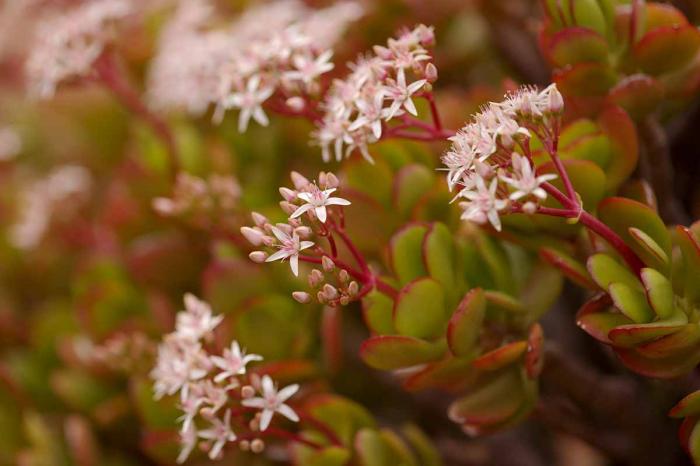The jade flower, also known as Crassula perfoliata var. Falcata, is a captivating succulent plant native to South Africa. Often referred to as the “propeller plant” or “airplane plant” due to its unique leaf shape, this flower is celebrated for its ornamental beauty and low maintenance requirements. In this article, we will explore what is the jade flower.
Physical Characteristics of the Jade Flower
The jade flower is a striking succulent with fleshy, green leaves arranged in a rosette pattern. The leaves are shaped like propellers or wings, giving the plant its distinctive appearance. They are thick and glossy, with a smooth surface that reflects light beautifully.
In addition to its eye-catching foliage, the jade flower produces small, star-shaped flowers. These blooms are typically white or pale pink and appear in clusters on tall, slender stems. The flowering period usually occurs in late winter or early spring, adding a splash of color to the plant’s already vibrant display.
Growing Conditions for Jade Flowers
Jade flowers thrive in a variety of conditions, making them suitable for both indoor and outdoor environments. Here are some key factors to consider when growing jade flowers:
Light Requirements
Jade flowers prefer bright, indirect light. They can tolerate direct sunlight but may require some protection during the hottest part of the day. Indoors, placing the plant near a south or east-facing window provides optimal light conditions. Outdoors, jade flowers should be positioned in a spot that receives morning sun and afternoon shade.
Soil and Potting
Well-draining soil is essential for jade flowers. A cactus or succulent mix works well, as it allows excess water to drain away and prevents root rot. If planting in a pot, ensure it has drainage holes to facilitate proper water flow.
Watering Needs
Jade flowers are drought-tolerant and require infrequent watering. Overwatering can lead to root rot, so it is crucial to allow the soil to dry out between waterings. During the growing season (spring and summer), water the plant moderately. In the winter months, reduce watering as the plant’s growth slows down.
Temperature and Humidity
Jade flowers prefer temperatures ranging from 60 to 75 degrees Fahrenheit (15 to 24 degrees Celsius). They can tolerate cooler temperatures but should be protected from frost. Jade flowers are not particularly sensitive to humidity, making them well-suited for typical indoor conditions.
Fertilization
Fertilizing jade flowers is not strictly necessary but can promote healthy growth. Use a balanced, water-soluble fertilizer diluted to half strength. Apply the fertilizer during the growing season, typically once a month, to support the plant’s development.
Propagation Techniques
Jade flowers can be propagated through several methods, including leaf cuttings and offsets.
Leaf Cuttings
To propagate jade flowers from leaf cuttings, follow these steps:
Select a healthy leaf from the plant. Gently twist it off, ensuring that the entire leaf is removed.
Allow the leaf to callous over for a few days to prevent rot.
Place the calloused leaf on a well-draining soil surface and lightly press it in.
Water sparingly until roots develop, usually within a few weeks.
Offsets
Offsets are small plantlets that grow at the base of the main plant. To propagate using offsets:
Gently remove the offset from the parent plant.
Allow the offset to callous over for a few days.
Plant the offset in a pot with well-draining soil.
Water lightly and provide appropriate light and temperature conditions.
Common Pests and Problems
While jade flowers are generally resilient, they can be susceptible to a few common pests and issues:
Mealybugs
Mealybugs are small, white insects that may infest jade flowers. They are often found in the crevices of the plant. Treat mealybug infestations with insecticidal soap or neem oil.
Spider Mites
Spider mites can cause stippling or discoloration on jade flower leaves. Increase humidity and use a miticide to manage spider mite infestations.
Root Rot
Root rot is a common problem caused by overwatering. Ensure proper drainage and avoid watering the plant too frequently.
See also: How to Prevent Garden Pests: A Florist’s Guide
Cultural and Symbolic Significance
Beyond its aesthetic appeal, the jade flower holds cultural and symbolic significance in various traditions. In South Africa, where it is native, the jade flower is appreciated for its role in local flora. Its unique appearance and adaptability make it a popular choice for gardens and indoor spaces alike.
In addition, jade plants, including the jade flower, are often associated with good fortune and prosperity in various cultures. In Feng Shui, jade plants are believed to attract positive energy and wealth. Their vibrant green color and attractive form contribute to their symbolic value.
Conclusion
The jade flower, with its distinctive propeller-shaped leaves and delicate flowers, is a remarkable addition to any plant collection. Its low maintenance requirements and adaptability make it an excellent choice for both novice and experienced gardeners. By understanding its growing conditions, propagation methods, and common issues, you can ensure that your jade flower remains a thriving and beautiful part of your home or garden.
Whether you are captivated by its unique appearance or drawn to its symbolic significance, the jade flower offers a rewarding and visually striking experience. As you care for and enjoy this resilient plant, you contribute to its legacy and embrace its role in your living space.


